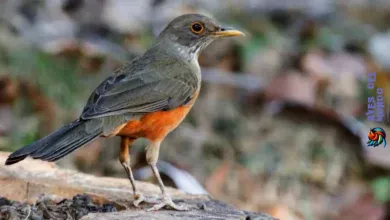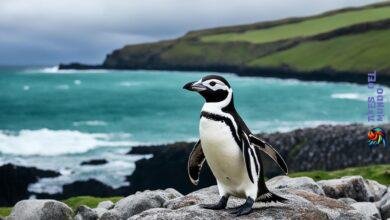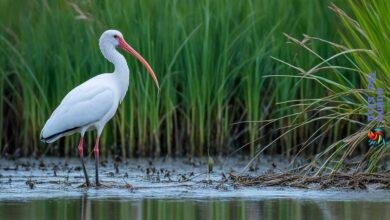The chase between birds of prey and waterfowl is as old as life itself. Picture a peregrine falcon diving at 200 miles per hour towards the ground. It’s a hunt. These raptors show off their power while ducks have their own escape tricks.
In the sky, hunters like falcons use sharp eyesight and speed to catch ducks. These tactics force ducks to find clever ways to escape. It’s a thrilling cycle of hunt and escape, shaping how both birds survive.
Exploring the skies reveals stories of survival with each bird’s move. Falcons dive with precision, while ducks use group smarts to dodge them. These stories teach us about nature’s complex dance of life and survival.
The Aerial Assault Tactics of Raptors
Raptors, known as mighty bird predators, use advanced hunting strategies. This shows their strength and clever tactics. The peregrine falcon is a top hunter with its impressive stoop dive.
Raptors also have incredible eyesight, making them efficient hunters. Their ability to see clearly from far away lets them rule the skies. Stealth is key in their hunting, putting raptors at the top of the food chain. Let’s explore how these tactics make them unmatched sky hunters.

Rapid Diving Attacks: The Peregrine Falcon’s Stoop
Watching a peregrine falcon hunt is both efficient and dramatic. They dive at speeds up to 200 miles per hour, like a bullet. This high-speed dive helps them catch birds mid-flight quickly and deadly.
Incredible Eyesight: How Raptors Spot Their Prey from Afar
Raptors’ eyesight is unmatched in the natural world. Their vision is so sharp, they can see fine details from far away. This makes them powerful sentinels of the skies, with vast hunting grounds.
The Art of Stealth: Hunting Strategies in Birds Of Prey
Stealth is crucial for raptors when hunting. They use their environment to stay hidden and surprise their prey. Being patient and then striking quickly defines their hunting strategy. This tactic is key in their predatory success.
| Raptor Feature | Function | Prey Implications |
|---|---|---|
| Peregrine Falcon Stoop | High-speed diving attack | Compels waterfowl to seek cover, leading to ecological behavioral adaptations |
| Raptor Eyesight | Detecting prey from vast distances | Forces prey to employ camouflage and stealth |
| Stealth Hunting | Covert approach and surprise attack | Prompts development of sensitive predator detection among prey |
The Influence of Predator Presence on Waterfowl Behavior
When a raptor glides silently in the sky, waterfowl below take notice. It’s a sign: predators are always around. Ducks and other waterfowl aren’t helpless, though. They’ve developed ways to survive over years of evolution.
By understanding how they adapt, we learn about the ecosystem’s balance.
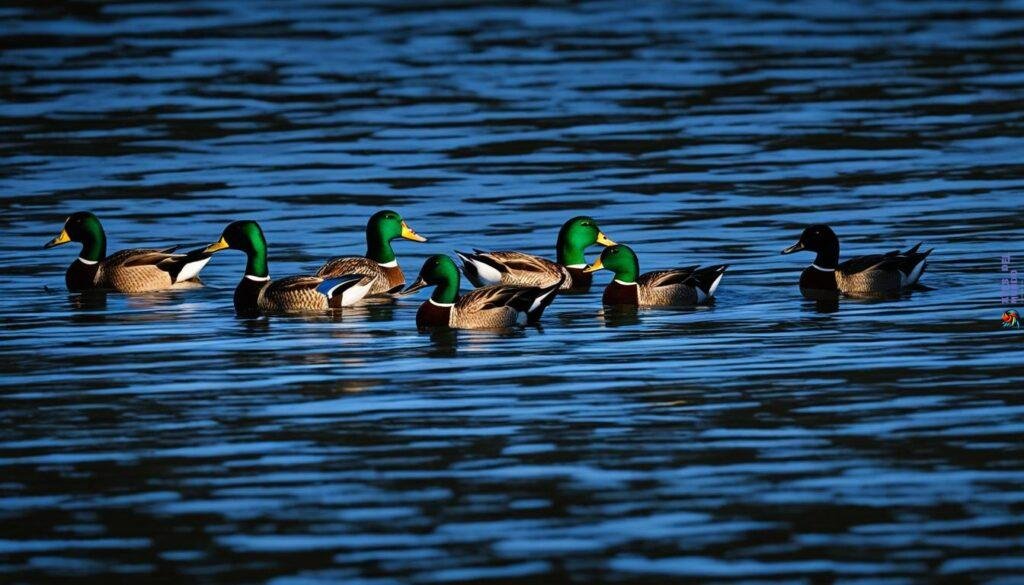
Nocturnal Feeding: How Waterfowl Avoid Daytime Predators
Nocturnal feeding is a smart move by waterfowl. It lets them look for food in the dark, staying away from predators. Changing from day to night feeding lowers their chances of being caught. This is a clever way to avoid predators.
Habitat Selection: Choosing Safety over Convenience
Habitat selection matters a lot for waterfowl survival. Choosing places with lots of plants and water hides them from predators. This shows how waterfowl behavior focuses on safety first. They might even migrate far to find safer places.
| Behavior | Advantages | Examples |
|---|---|---|
| Nocturnal Feeding | Reduced visibility to predators, lower competition for food | Gadwalls in Louisiana |
| Habitat Selection | Access to protective cover, potential for more abundant resources | Wetlands with dense vegetation |
| Relocation Strategies | Increased survival chances through adaptable behaviors | Seasonal migrations to areas with minimal predator threats |
The tactics of nocturnal feeding, smart habitat selection, and relocating show waterfowl behavior complexity. These survival tactics underline the birds’ resilience as they face natural challenges.
The Defensive Maneuvers of Ducks and Geese
Ducks and geese are crafty survivors in the wild. They’ve developed a range of defensive maneuvers to escape predators. Flocking behavior is key, where they group together for safety and strength. Their feathers also play a big role in hiding from danger, thanks to protective coloration.

Flocking for Safety: Confusing Predators Through Numbers
When danger nears, waterfowl quickly gather together. This behavior is a brilliant display of teamwork and an waterfowl defense strategies. By moving in close, chaotic groups, they trick predators. This confuses the hunter, making it hard to target just one bird. It shows how sticking together can save them.
The Protective Coloration of Female Ducks
Female ducks have another trick up their sleeve: their feathers. During nesting, they use protective coloration to blend in perfectly with their surroundings. This excellent camouflage is their first shield against threats from the sky, making them nearly invisible. Below is a table showing how different species use this strategy:
| Waterfowl Species | Coloration Type | Behavioral Benefit |
|---|---|---|
| Northern Pintail Female | Mottled Brown and Tan | Camouflage during nesting |
| Mallard Male (Eclipse) | Dull Brown | Reduced visibility during molting |
| Canvasback Female | Brown with White Highlights | Concealment in marsh vegetation |
| Wood Duck Male (Eclipse) | Cryptic Brown | Low detection risk while molting |
Waterfowl are masters at self-defense, thanks to their smart behaviors and physical traits. Through clever flocking behavior and protective coloration, they avoid predators. Their skills are not just impressive but vital for their survival.
Understanding Raptor-Prey Size Dynamics
The balance of nature shows us many things, like how raptors and their prey interact. This relationship, called raptor-prey dynamics, shows us how the size of a predator affects which animals it hunts. The size of these birds plays a big role in their hunting success in bird communities.
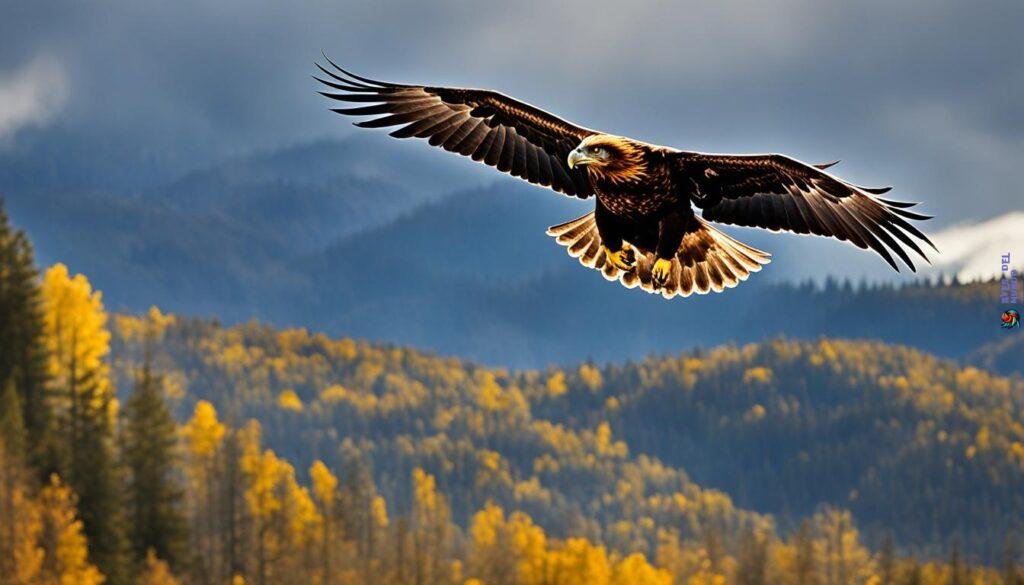
The Significance of Wingspan: Hunting Capabilities of Different Raptors
A raptor’s wingspan is key to its hunting skills. A big wingspan lets these birds fly for a long time and grab their prey with ease. We see this in how big raptors choose bigger prey, something smaller birds can’t do because of their size.
Golden Eagles and Larger Waterfowl: Size Matters
Golden eagles are a prime example of this. They have a wingspan of up to 7 feet, making them skilled at hunting large waterfowl like cackling geese. This shows the importance of size in hunting. On the other side, smaller birds are always on the lookout, trying to avoid becoming prey. They develop clever ways to escape.
By studying how a raptor’s body and prey choices are linked, we learn a lot about different birds’ behaviors and survival tricks. Acknowledging the size of these predators helps us understand raptor-prey dynamics better. This understanding goes beyond school—it helps us see the deep impacts of these dynamics in nature.
Survival through Evasion: Waterfowl’s Response to the Falcon
Understanding how waterfowl avoid danger is key when we look at their battles with peregrine falcons, their tough enemies. Falcons are amazing hunters. Their presence changes how whole groups of ducks act. To avoid being caught, ducks have learned to stay on water where they’re safer.
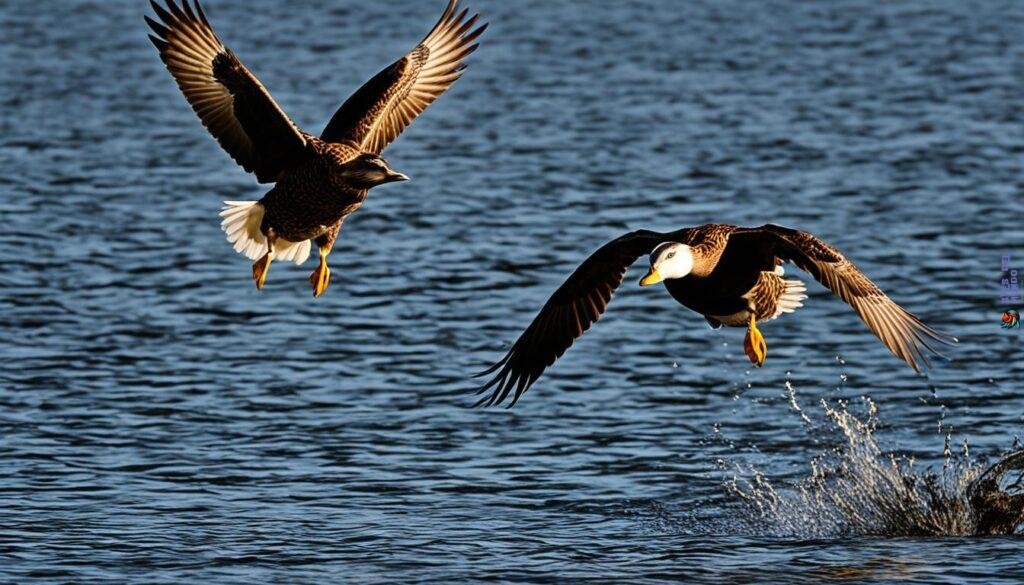
On-Water Safety: The Anti-Predatory Response to Peregrine Falcons
Ducks play a life-and-death game against falcons. They stick near water for safety, using smart evasion tactics. Rather than flying away and risking capture, they stay on water. This choice shows how ducks have adapted their survival strategies to avoid falcon attacks.
By staying on water, ducks use their environment to help them. They know water can protect them from falcons. This behavior shows how ducks are smart and adaptable. It also shows the beauty of nature and the strong will to live.
Bird Hunting Techniques Utilized by Various Raptors
Raptors have unique bird hunting techniques. They master the skies and use a selective prey approach and hunting strategies. This delicate dance is all about finding the right balance between risk and reward.

The Selective Prey Approach: Why Some Raptors Target Specific Waterfowl
Some raptors prefer to hunt specific waterfowl. This method, known as selective prey approach, lets them save energy. For example, ospreys mainly catch fish. This shows they have mastered hunting in their niche.
Balancing Risk and Reward in Raptor Hunting Strategies
Raptors consider the dangers and benefits when hunting. The golden eagle is a perfect example. They hunt larger waterfowl, which is risky but rewarding. These strategies show how their survival instincts work in the wild.
- Opportunism versus specialization: Eagles may adapt to available prey, while falcons may demonstrate incredible speed and precision targeting mid-flight migratory species.
- Habitat influences: Forest-dwelling raptors use ambush tactics compared to the open-sky dive-bombs of peregrines.
- Seasonal adjustments: Owls and hawks may adjust their hunting strategies based on the time of year and prey availability.
Impact of Plumage on Waterfowl’s Predation Risk
In the world of waterfowl, plumage matters a lot for survival. Feather color changes can greatly affect a bird’s risk of being eaten. Birds adapt their feathers for better camouflage, especially at certain times of the year. This isn’t just for looks. It’s key for staying safe from predators.

Eclipse Plumage: A Camouflage Tactic during Molting Season
Eclipse plumage is crucial for ducks after breeding season. It’s a duller set of feathers that helps them merge with their surroundings. This lowers their chances of being spotted by dangers like raptors. For males, this dull look is quite different from their bright breeding colors. It’s an excellent camo while they wait for new feathers.
Nesting in Concealment: Female Ducks’ Strategy to Avoid Detection
Females take nesting concealment seriously to safeguard their eggs. They hide their nests in dense areas, far from predators’ eyes. Choosing such spots for their nests helps them dodge threats. This keeps their eggs and young chicks safe.
The plumage of waterfowl plays a big role in dodging predators. Whether it’s their eclipse look or where females choose to nest, it all adds up to survival. As we watch these birds, let’s appreciate how their looks and actions are part of their survival strategy.
Ecological Balance: Managing Raptors and Waterfowl Populations
Keeping a balance between raptors and their waterfowl prey is crucial for different bird species to survive. Good ecosystem management helps create a natural balance that supports bird population sustainability. It’s important to carefully use conservation practices to maintain this balance.
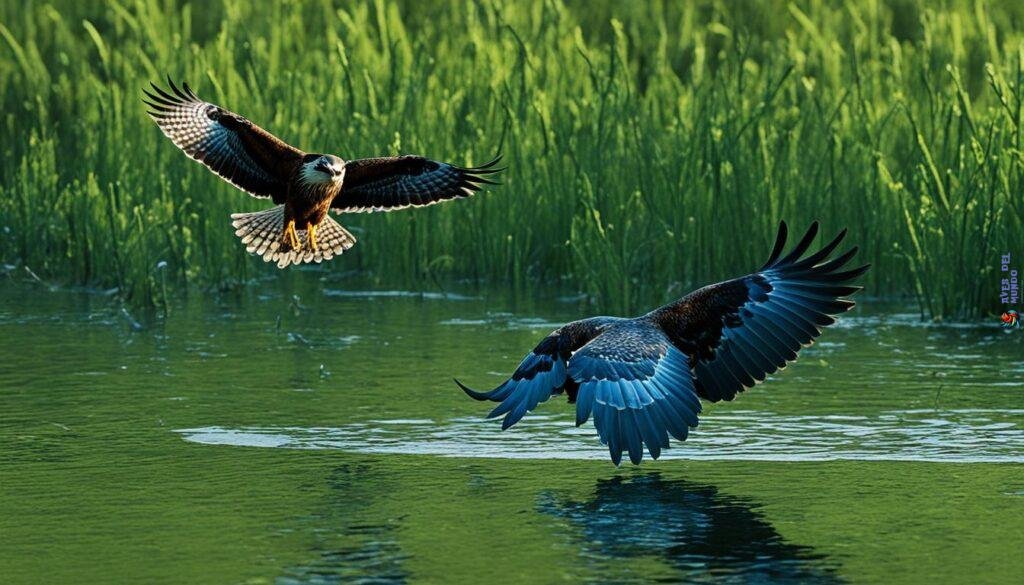
Ecosystem Management and its Role in Sustaining Bird Populations
Taking care of our environment means protecting where wildlife lives and encouraging a variety of species. Efforts in ecosystem management are critical for keeping both raptor and waterfowl numbers healthy. These efforts include things like keeping rivers clean for birds to find food and shelter, and making sure laws prevent harming their natural environments too much.
Conservation Practices that Benefit Both Raptors and Ducks
Using the right conservation practices helps create places where both raptors and waterfowl can live well. These methods aim to keep the natural balance between these hunters and their prey in healthy areas. Here are some key actions that help both:
| Conservation Practice | Benefits for Raptors | Benefits for Waterfowl |
|---|---|---|
| Wetland Restoration | Provides plentiful hunting grounds | Ensures habitat for feeding and nesting |
| Reforestation Projects | Enhances nesting and roosting options | Offers cover and additional food sources |
| Prairie Conservation | Preserves hunting territory | Maintains breeding and brooding habitats |
| Control of Invasive Species | Safeguards food supply | Prevents habitat degradation |
Initiatives like these support every part of the birds’ lives, from having babies to finding food. By continuously supporting these strategies, we help ensure we’ll always see these amazing birds in the sky.
Humans and Birds of Prey: The Role of Falconry in Duck Hunting
Imagine standing in a field, feeling the cold air on your cheeks. You’re about to take part in an ancient tradition. This tradition combines your hunting skills with the natural abilities of birds of prey. It shows the lasting bond between humans and raptors in the sport of duck hunting.
Your hands briefly hold these amazing birds before they fly into the sky. This moment shows the deep connection and trust between humans and birds. Watching your bird partner dive and chase ducks is like having a front-row seat to nature’s hunting technique. It teaches you unique hunting skills that have been used for centuries.
Picture yourself blending in with your surroundings, your trained falcon or hawk standing out against the sky. Falconry adds something special to your hunting, connecting old methods with modern practice. These birds, with their amazing flying skills, are more than just hunting tools. They connect us to the wild and the excitement of the chase. Let your admiration for these birds grow as you learn from them, making your hunting experiences richer.
